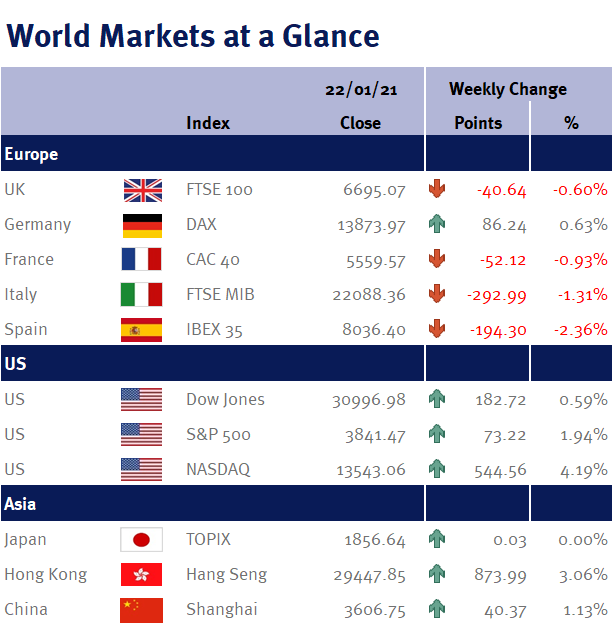For example, US economic data was extremely encouraging: not only did the weekly US initial jobless claims fall to 900,000 and continuing claims to 5.05m, but the previous week’s data was revised lower (this is good news as it indicates that the US employment market isn’t weakening as last week’s data initially suggested). US housing data and the Philadelphia Fed Business Outlook Survey completely smashed expectations, with housing starts rising 5.8% to 1.67m (its highest level since September 2006), while the Philly Fed (as it is more commonly known) jumped to 26.5 from last month’s reading of 9.1 (its highest reading since last February).
Additionally, today’s (Friday 22 January 2021) US PMIs (Purchasing Managers’ Index) comfortably exceeded expectations and showed improvements from last month, with readings of 59.1 for manufacturing and 57.5 for services. 50 is the line separating expansion and contraction, so not only do these readings show that the US economy continues to expand, but more importantly, the expansion is accelerating.
And to top it off, the US company earning session continues to exceed expectations. Although it is still early days as only 68 of the 500 constituents in the S&P 500 have reported, a staggering 57 have beaten expectations.
Unfortunately, it has been a very different story in Europe and the UK: UK manufacturing PMI fell from 57.5 to 52.9 (although it is still expanding, the expansion is slowing), while services unsurprisingly fell to 38.8 from 49.4 due to the stricter lockdown restrictions; Eurozone manufacturing PMI fell to 54.7 and services fell to 45.0 – again due to lockdown restrictions.
While these readings are disappointing, the obvious recovery stimulus is the vaccine roll-out as this will enable the current lockdown restrictions to be eased and allow the service sector to fully reopen.
Looking ahead to this coming week, the main events are the Fed monetary policy meeting on Wednesday (27 January 2021) and the weekly US jobless claims data the following day. Other US data includes durable goods orders and PCE (personal consumption expenditures – the Fed’s preferred inflation measure), while in the UK we have employment data (unemployment rate and average weekly earnings).
Investment Management Team


